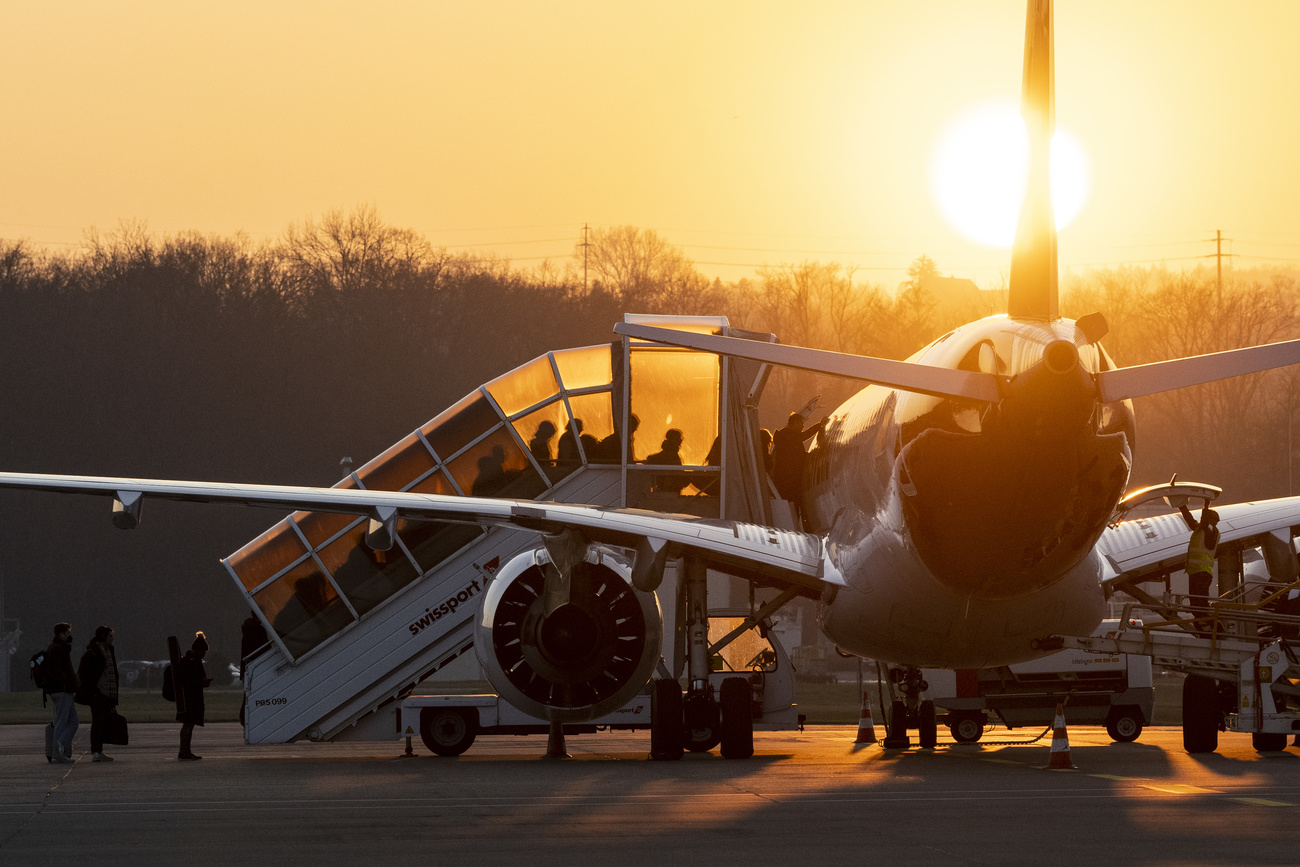As private jet flights soar in Switzerland, so do their CO2 emissions

Private jet flights and their emissions have soared in recent years, and Switzerland is one of the top destinations for the heavy-polluting planes. The small Alpine state is a magnet for ultra-wealthy jet travellers, especially in winter when they fly to luxury resorts.
On a clear late-January morning, a steady stream of private jets descends through the narrow snow-capped valley to Engadine AirportExternal link, one of Europe’s highest airports (1,707 metres) that serves the nearby resorts of St MoritzExternal link and DavosExternal link.
A Gulfstream jet from Milan lands. The driver of a black Mercedes van discreetly welcomes a couple of passengers off the aircraft before whisking them away. It’s followed by another jet, this time from Brussels, which ground staff park alongside half a dozen other luxury planes waiting to depart.
January and February are intense months for the tiny airport with between 30-100 jets coming and going on some days. In recent years, it has welcomed growing numbers of jets from Europe, the United States, Brazil and the Middle East. The fairly basic facility registered a total of almost 17,300 flight movements in 2023.
Last weekend was a particularly busy time. St Moritz hosted 25,000 visitors for the 40th Snow Polo World Cup.External link Professional polo players from Argentina, UK and Spain took part, watched by locals, VIPs and “people who fly in or who have holiday homes [and] who love snow polo”, Katja Grauwiler, the event’s director of communications, tells SWI swissinfo.ch.
The competition came days after the World Economic Forum (WEF) annual meeting in Davos. Private jets brought many of the 3,000 world leaders, businesspeople and other movers-and-shakers to Switzerland. They landed in Engadine, Zurich and Altenrhein airports, then took helicopters to Davos. The conference is a hotbed of private jet activity. According to Greenpeace, over 1,000 private flights landed in Switzerland for the weeklong WEF conference in 2022.
Switzerland is a well-known hub for jets year-round. A Greenpeace-commissioned reportExternal link from 2022 found the country was responsible for almost 5% of Europe’s private jet emissions with a 63% rise in private jet departures compared to 2021.

Paris-Geneva and Farnborough (London)-Geneva were amongExternal link the top ten busiest routes in Europe in 2023. The airports in Zurich, Sion, Gstaad and St Moritz are also busy throughout the year.
Though used by just 0.003% of the world’s population, private jets are the most polluting form of transport. How the planes are used, and the environmental impact they have, is only now becoming clear thanks to detailed independent research.
Private jet planes and flights on the rise
In the past two decades, the global jet fleet has expanded from around 10,000 in 2000 to 23,100 in mid-2022, a 2023 reportExternal link by the Institute for Policy Studies (IPS) think tank shows. Since then, the business aviation sector has continued to report growth, with another 8,100 jets expected to enter service by 2033.
Private jet flights have risen sharply in the post-pandemic period, especially in the US and EuropeExternal link. Recent researchExternal link published in Nature of 19 million flights between 2019 and 2023 reveals a spectacular 50% rise in CO2 emissions. Researchers calculated that the flights produced 15.6 million tonnes of CO2 in direct emissions in 2023, or about 3.6 tonnes of CO2 per flights, from 10.7 million tonnes in 2019.
Worldwide, business jet flights hit 3.6 million in 2024, 30% more than 2019, data from the aviation consultant WingX showsExternal link.
“We have seen a constant increase, suggesting that wealth growth is the main driver,” Stefan Gössling, a researcher at Linnaeus University, Sweden, and co-author of the recent Nature studyExternal link, told SWI swissinfo.ch.
Jet industry estimates suggest there were around 256,000External link jet travellers in 2018, with average wealth of $123 million and upwards.
The US has over two-thirds (18,163) of the world’s private jets, way ahead of Brazil (927) and Canada (770). Malta holds the record for registered jets per resident (46.5 per 100,000); Switzerland ranks third (3.76).
Outside the US and Europe, Brazil, the Middle East and the Caribbean are popular private jet hotspots.
Short trips for leisure purposes
The above-mentioned studyExternal link in Nature tracked over 25,000 registered jet-type private aircraft and almost 19 million private flights between 2019 and 2023. Much of the use was for leisure, flight pattern analysis confirmed. The study also highlighted the impact of flights to and from high-profile international gatherings, including the 2022 FIFA World Cup in Qatar (1,846 fights), and the UN COP28 climate summit in UAE (291).
Researchers also discovered that half of the jets travelled less than 500km and 900,000 were used like taxis for trips of less than 50km. In the US, celebrities such as Taylor SwiftExternal link and Kylie Jenner have faced criticism over heavy private jet use and ultra-short tripsExternal link. The T3 Transportation Think Tank identified numerous examples of short hops in Switzerland, including 152 from Sion to Geneva (90km) and 84 from Lausanne to Geneva (60km).
“There’s only one plausible reason for that: ‘empty legs’,” explains Frederic Rudolph, a researcher at the German think tank. “Empty legs” are private charter flights that fly without passengers on their way to reposition themselves from one airport to another.
>> Check out this short video on the soaring number of private jet flights in Switzerland.
The main conclusionExternal link of the Nature study is clear: private aviation is “making a growing contribution to climate change”.
Private jets are well known for being excessively heavy polluters. Although jet travel makes up only 4% of the global aviation marketExternal link, it produces about 10 times as much greenhouse gas per passenger.
The T3 Transportation Think Tank estimates that a typical private jet flight generates 4.46 tonnes of CO2 per flight, more than the annual CO2 emissions of a Swiss residentExternal link (without taking into account emissions generated abroad).
Conscious of their environmental impact, some parts of the jet industry have tried offering customers eco-friendly options like “sustainable aviation fuels” on their flights or carbon offsets.

More
Carbon-neutral flying by 2050 is possible, says Swiss government
New business models, more accessible
The recent scientific reports further underline the sector’s ongoing boom after wealthy flyers switched to private aviation when Covid forced lockdownsExternal link around the world. Growing demand has been driven by concerns over health and safety, as well as a desire for privacy, flexibility and personalised service.
New business models are also making luxury private jet travel more accessible. Owing and running a private aircraft that costs tens of millions of Swiss francs may only be within reach of the ultra-rich. But taking a jet is increasingly possible via firms that offer on-demand chartering, membership programmes or fractional ownership schemes.
“I think it’s still very much an elite activity to use private jets, even though from what I hear the charter fees are almost reasonable for some distances,” notes Gössling.
Cut-price offers on “empty leg” jet flights that have been repositioned have also made the industry more affordableExternal link. For example, a one-way “empty leg” from Munich to Geneva last summer was on sale for €1,190 after an 80% reduction, Swiss public television, RTS, reported.
Higher taxes and regulation
Ultimately, aviation, and private jets in particular, look set to remain firmly in the sights of environmental activists, who want to see heavier taxation and regulation to disincentivize their use and to level the playing field.

Critics constantly bemoan the fact that airlines, unlike motorists across Europe, pay zero duty on their fuel. Plane tickets are mostly exempt from VAT, as well.
The IPS think tank suggests a 10% tax on second-hand private jets and 5% on new jets, a doubling of the fuel tax, a tax on short trips and a contribution towards the financing of airport infrastructure.
Others prefer more spectacular headline-grabbing forms of protest. During this year’s WEF, almost 30 Greenpeace activists invaded Engadine Airport to symbolically “confiscate” private jets next to the runway, attaching inflatable ball-and-chains to parked aircraft for a photo-op to highlight the growing use of private jets by the super-rich.
Edited by Veronica De Vore/Gabe Bullard

More
Newsletters

In compliance with the JTI standards
More: SWI swissinfo.ch certified by the Journalism Trust Initiative










You can find an overview of ongoing debates with our journalists here . Please join us!
If you want to start a conversation about a topic raised in this article or want to report factual errors, email us at english@swissinfo.ch.